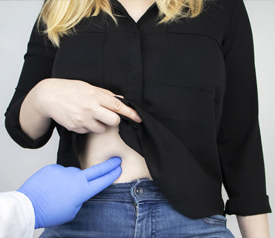
Ostomy surgery is an increasingly common treatment for patients with Crohn’s disease. With over 450,000 people with stomas in the United States and 120,000 new ostomy surgical procedures performed each year, a growing number of patients must contend with the difficulties of stoma management. However, with guidance from a health care professional, stoma patients can live healthy, active lives while minimizing their risk of injury, infection, and other problems.1
Ostomy Management Challenges & Crohn’s Disease
Living with a stoma can be difficult for many patients, particularly when they are first learning how to manage it. Leak prevention, pouch emptying, and regular skin care are all critical to ensuring that the stoma functions properly and that there are no complications. This management can be complicated and difficult for many patients. It can also be challenging for patients to stay active because the stoma may become dislodged or the medical adhesive may loosen when it is exposed to moisture. For patients to manage these challenges effectively, they must be educated by a health care professional on stoma care best practices.
Below is a selection of articles that could help those with Crohn’s disease or a new ostomy.
- Common Ostomy Issues & Possible Solutions
- Peristomal Skin Issues & Ostomy Care
- Ostomy Care: Preventing Skin Irritation Around the Stoma
- Life with a New Ileostomy
- Traveling with an Ostomy by Plane
- Preventative Skin Care & Ostomy
- Securing Gastrostomy Tubes & Tape Sensitivity
Four Useful Teaching Points
1. Emptying the Pouch – One of the first questions patients will ask when they decide to undergo stoma surgery is how often they must empty the pouch. This is frequently an uncomfortable subject for them. However, emptying the pouch regularly is one of the most important ways to prevent leaks and other complications, so its importance must be stressed. Assure patients that it is a relatively simple procedure and that the pouch should be emptied when it is one-third to one-half full. It is also often reassuring that the emptying process is seamless and can be performed while sitting on the toilet.
2. Skin Care – Protecting the skin around the stoma is important for preventing various complications, including irritant contact dermatitis, papular overgranulation, and infection.2 To prevent these issues, it is important that patients regularly clean around the stoma by using a pH-balanced cleansing product and that they use a skin-safe moisturizer around the affected area. Barrier products can also help reduce the effects of moisture on the skin.3
3. Appliance Securement – For the stoma to function properly and to prevent leaks, it is critical that the stoma pouch be secured using strong, gentle medical adhesives. Using a long-lasting medical adhesive that is water resistant will allow the patient to lead a fuller, more active lifestyle without risk of leaks. It is also important to avoid irritation and mechanical trauma from the adhesive. Allergic contact dermatitis can occur with certain medical adhesives, thus causing erythema, itching, and pain. Mechanical trauma from frequent removal of adhesives can also cause skin damage and other issues in the peristomal area.2 This makes it extremely important to choose a medical adhesive that is gentle and hypoallergenic.
4. The Importance of Compliance – Ultimately, no amount of teaching will help if patients do not comply. That’s why it is critical that health care professionals stress that these guidelines are for the benefit of the patient and that adhering to them will mean less risk of complication, fewer trips to the doctor, and a simpler experience. Encouraging patients to be involved in their own health and helping them understand that living with a stoma does not have to significantly detract from their quality of life are critical.
Although patients will sometimes have to rely on their health care professional’s expertise when caring for their stoma, with the right education, they can effectively manage most day-to-day issues themselves. These guidelines are just a beginning foundation for good at-home stoma management. By comprehensively educating stoma patients about risks and best practices when managing their stomas, health care professionals can help ensure that patients have a positive, complication-free experience.
References & Crohn’s disease
1. Turnbull GB. The ostomy files: ostomy statistics: the $64,000 question. Ostomy Wound Manage. 2003;49(6). Available at: www.o-wm.com/content/ostomy-statistics-the-64000-question. Accessed May 31, 2018.
2. Robertson M. Peristomal Complications: Assessment & Management. Available at: http://www.wrha.mb.ca/education/files/MaryRobertsonPeristomalComplicatio…. Accessed May 31, 2018.
3. Goldberg M. Preventive Skin Care. National Pressure Ulcer Advisory Panel. 2015. Available at: https://www.npuap.org/wp-content/uploads/2015/02/2.-Preventive-Skin-Care…. Accessed May 25, 2017.

